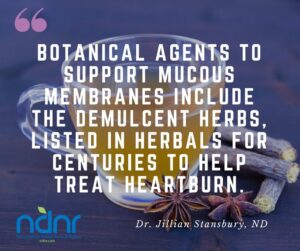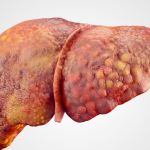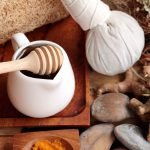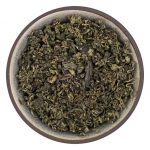Seaweed, Chewing Gum, and GERD
Jillian Stansbury, ND
Botanical Insights
Proton-pump inhibitors (PPIs) and histamine (H2) acid blocking drugs are the mainstay of acid reflux treatment. With an estimated 100 million people experiencing occasional symptoms, and 15 million suffering from heartburn on a daily basis, sales of these drugs currently exceed 10 billion dollars per year. However, the innocuous public opinion regarding ant-acid use is undeserved. Regular use of antacids can promote dysbiosis of the small intestinal bacterial flora (SIBO),1 and exacerbate the tendency of NSAIDS to injure the intestinal mucosa.2 Furthermore, long-term antacid use has been linked to an increased risk of peritonitis and Clostridium difficile infection in vulnerable populations.3,4 One study reported that children on acid-blocking drugs have a greater than 4-fold higher risk of developing Clostridium difficile infections compared with other children.5 PPIs specifically have been shown to exacerbate intestinal erosions and inflammation related to aspirin and steroid use.6 Early evidence points to other possible issues such as increased risks of pneumonia in stroke patients,7 fractures in osteoporotic adults,8 lower respiratory tract infections in susceptible individuals,9 and chronic kidney disease,10 as well as impaired semen quality, 11 and COPD exacerbation.12
With such serious complications, it seems best to avoid these medications, and instead work on improving GI health and motility, protecting mucous membranes and barriers, and promoting beneficial gastrointestinal flora. Because most of the millions of people who use such drugs on a regular basis suffer symptoms immediately when they skip a meal’s dose, alternative practitioners need to be able to offer safe and rapidly effective alternatives.
Most readers are aware of the benefits of dietary approaches including increasing fiber, decreasing difficult to digest foods such as meat, and dealing with food sensitivities, all of which can support a beneficial intestinal ecosystem. Weight loss often improves reflux for patients who are overweight, and smokers who are able to quit are also likely to have improvement. All patients should be coached to avoid large meals, and eat instead frequent small meals. Many GERD patients will benefit from elevating the head of the bed, and avoiding laying down for a full 3 hours after eating. Some patients may require digestive enzymes, others biliary support and cholagogues; some may require antimicrobials, or even pharmaceutical antibiotics when Helicobacter or SIBO (small intestinal bacterial overgrowth) are present; others may benefit from nervines and stress relief. Some of these ideas are exemplified in the formulary that follows. In general, all patients with GERD benefit from demulcent herbs, probiotics, and agents that support optimal gastric emptying and intestinal motility.
Demulcents
 The allopathic medical approach involves opposing symptoms: in GERD, symptoms are opposed with antacids. An alternate medical philosophy for GERD is to build a protective barrier for the gastroesophageal mucosa. In addition to the long-term consequences associated with antacid use, the acute effect of blocking acid can create a vicious cycle whereby pH sensors note insufficient acid and mount an effort to produce more, compelling a person to use more antacids.
The allopathic medical approach involves opposing symptoms: in GERD, symptoms are opposed with antacids. An alternate medical philosophy for GERD is to build a protective barrier for the gastroesophageal mucosa. In addition to the long-term consequences associated with antacid use, the acute effect of blocking acid can create a vicious cycle whereby pH sensors note insufficient acid and mount an effort to produce more, compelling a person to use more antacids.
Botanical agents to support mucous membranes include the demulcent herbs, listed in herbals for centuries to help treat heartburn. Herbs such as Althea officinalis and Ulmus fulva are classic for this purpose, and are most effective as teas, compared to tinctures, and better yet, as medicinal foods such as the traditional Slippery Elm gruel. Aloe vera gel can improve reflux symptoms13 and may be included in teas and smoothies. Simply making the stomach contents more viscous by consuming demulcent “snacks” prior to meals may thicken fluids and thereby inhibit reflux.14 Glycyrrhiza glabra (licorice) is shown to improve the quality and quantity of mucous released from intestinal goblet cells, and has anti-inflammatory and ulcer healing effects.15 While these herbs can be an important part of a long-term protocol, they are unlikely to provide substantial relief of severe reflux in the short term.
So what can help quickly, even immediately, for a patient we are trying to wean off of acid blocking drugs? Alginates are one tool that can be added to our tool kits. While alteratives, diet changes, motility enhancing therapies, probiotics, and enzymes can gradually help improve the integrity of the gastroesophageal sphincter and the health of the entire gastrointestinal ecosystem, alginates may help give us some quick relief.
Seaweed and Alginates
Alginates occur in the cell walls of brown algae including the kelps and bladderwracks. Like demulcents, alginates are polysaccharides with mucilaginous physical properties. Alginate-rich seaweeds are currently the world’s largest sea “crop,” as they are used in large quantity as raw materials to produce purified crude alginates. These alginates are used as stabilizers and emulsifiers in the food industry, and to make gums and gels that can be fashioned into foods such as grain-free seaweed “noodles.” Alginates may also be processed into fibers used to make bandages for wound care, and into beads impregnated with various drugs, nutrients, and herbal medicines to enhance their delivery.16 Kelp (Macrocystis pyrifera) is used in alginate production in California, and Laminaria japonica, Laminaria hyperborean, and Ascophyllum nodosum are used in other regions of the world.
Alginates can be highly useful in allaying acute GERD symptoms.17-20 Alginates bind stomach acid and form a gel of neutral pH, which is less easily moved back into the esophagus. Alginates form a gel that can bind stomach acid at the gastroesophageal junction and create a barrier that helps resist reflux. Because stomach acid often floats on top of ingested food in the stomach, a situation referred to as an “acid pocket,” the consumption of sodium or magnesium alginate after meals may bind the acid and cap off the gastroesophageal sphincter by forming a gel. Alginates impregnated with calcium carbonate are also being developed to remedy reflux.21 Popular commercial treatments for heartburn are made with combinations of alginates and mineral carbonates; however, some of them also contain aluminum hydroxide. In China, alginates impregnated with Coptis chinensis and Evodia rutecarpa are shown to protect the gastric mucosa from alcohol-induced injury.22 Sodium alginate is included in some herbal products aimed at treating GERD.
Enhancing Motility
Impaired motility may contribute to GERD, as inability to pass stomach contents along predisposes to reflux. Gastric emptying is largely controlled by hormonal factors, but there is also a foundational electrical rhythm in the gastric smooth muscle, acting like a pacemaker.23 Delayed gastric emptying and gastroparesis may contribute to dysbiosis and allow Helicobacter pylori to become established, and has been correlated with stomach pain and belching,24 as well as Crohn’s disease.25
Chewing stimulates saliva flow and digestive motility, and may thereby reduce GERD and gastroparesis. Studies suggest that chewing alone may reduce reflux26,27 and medicinal chewing gum, made with licorice and papain, is available for this purpose. Gum chewing speeds the clearance of refluxate from the esophagus, a benefit that may endure for hours. Xylitol chewing gum, which has received attention for its benefits to dental health, has also been shown to speed recovery of gastrointestinal motility following major surgeries.28 As it could do no harm, patients with GERD may be encouraged to chew gum for one hour after all meals.
Mucoadhesivity
In some cases, loss of mucosal integrity may contribute to esophageal reflux. The barrier integrity and general moist spongy nature of the digestive mucosa may be compromised due to aging, dysbiosis, infection, and conditions that limit mucosal regeneration. Nourishing herbs that support connective tissue repair, such as Centella asiatica, are classic for healing ulcers, trauma, and skin rashes, and can be used as a base for teas intended for long term use in GERD patients. Calendula officinalis may improve circulation to the mucosa and is another, safe and gentle herb for long term use.
Herbs that adhere to mucosal surfaces may add to the protective effect of a formula and contribute to pain relief. Alginates, as well as pectin30 and hyaluronic acid,31,32 have demonstrated mucoadhesivity. Locust bean or guar gum from Parkia biglobosa33 and polysaccharides from Tamarindus indica seeds34,35 are also mucoadhesive.
Glutamine
Glutamine is the most abundant amino acid in the human body, with important roles in recovery from illness, stress, and injury. In the gut, glutamine supports the rapid turnover of intestinal mucosal cells, and the small bowel takes up more glutamine than any other tissue.28 Glutamine can easily be added to teas, the day’s drinking water, and medicinal foods in protocols for GERD.
Preventing Gastroesophageal Cancer
The gradual replacement of esophageal epithelium with cells more typical of the lower digestive track, known as Barret’s esophagus, increases the risk of esophageal cancer. Insufficient saliva and mucosal secretions contribute to Barrett’s esophagus, and may be improved by prolonged mastication,36 such as through chewing gum. Curcuma longa, noted for numerous anti-cancer affects, may reduce epithelial transformation in an irritated esophagus.37 Panax ginseng may ameliorate inflammatory changes that occur with chronic GERD, and is especially indicated when GERD occurs with chronic stress and emotional symptoms.38 Berries and their flavonoids can be included in a therapeutic diet and formulas to treat GERD to reduce inflammation and possibly the risk of cancer.
Treating Helicobacter pylori Infection
Helicobacter pylori infections sometimes contribute to the development of GERD, and herbs with activity against H. pylori may be helpful in therapies for GERD. However, because conditions in the digestive ecosystem may allow, if not invite, this microbe to proliferate, antimicrobial therapies are unlikely to be effective when used alone. Herbs including Matricaria recutita and Hydrastis canadensis have been found to deter H. pylori growth and may be superior to pharmaceutical antibiotics by simultaneously offering anti-inflammatory and digestion-enhancing effects.39 Matricaria has been found to protect against alcohol-induced gastric ulceration, and appears to work by supporting anti-oxidant pathways.40-43 A short list of herbs shown to be active against H. pylori are offered in the sidebar.
Sweet and Sour Alginate “Cordial” for GERD
Mg or Na Alginate 1 tbsp (Available with a bit of searching)
Pectin ½ tsp
Tamarind paste ¼ tsp
Licorice solid Extract ¼ tsp
Hyaluronic Acid ¼ tsp
Hot Water or Tea 1 Cup
Combine all ingredients available in the hot water or tea, stirring vigorously. Drink immediately. Use after meals, possibly with digestive enzymes to offer further digestive support.
Carminitive Tea Formula for GERD and Helicobacter Infection
Foeniculum vulgare 4 oz whole seeds or powder
Achillea millefolium 2 oz, finely ground flowers
Matricaria chamomilla 2 oz flowers
Rosmarinus officinalis 2 oz fine cut leaves
Zingiber officinale 2 oz finely cut dried root
Glycycrrhiza glabra 2 oz shredded root
Place 2 -3 tsp of the herb blend per cup of hot water in a sauce pan. Bring to a gentle simmer, remove immediately from heat, and let stand covered for 10 minutes. Strain and drink freely, at least 3 cups per day.
Anti-Microbial Tincture Formula for GERD and Helicobacter Infections
Achillea millefolium 8 ml
Curcuma longa 8 ml
Hydrastis canadense 4 ml
Rosmarinus officinalis 4 ml
Gentiana lutea 4 ml
Zingiber officinale 4 ml
Fennel Essential oil 20 drops
Take 1-2 tsp 5-6 times a day, reducing as symptoms improve.
Licorice: Aloe Paste for GERD and Esophagitis
Aloe gel 1 ounce
Tamarind paste 1 Tbl
Licorice solid extract 1-2 tsp
Glutamine Powder
Place all in a small bowl and blend vigorously with a fork. Take 1 tsp 3 times a day directly from a spoon or diluted with one of the teas shown above. Additional doses may be used as needed for acute symptom relief. Use the entire recipe over the course of the day, and make fresh each day.
Licorice Syrup for Barrett’s Esophagitis
Curcuma longa 1/3 oz
Panax ginseng 1/3 oz
Fucus vesiculosus 1/3 oz
Glycyrrhiza glabra solid extract 1 oz
The licorice solid extract can help the other herbs cling, at least momentarily, to the esophagus. The formula can be stirred into berry powder such as Crataegus monogyna or Vaccinium myrtillus powders.
HELICOBACTER INFECTIONS
Helicobacter pylori has been shown to be highly associated with peptic ulcer diseases and is a potent carcinogen associated with gastric carcinoma.44 Many herbs have been shown to have activity against H. pylori, including Achillea millefolium, Azadirachta indica, Carum carvi, Coptis, Curcuma longa, Elettaria cardamomum, Foeniculum vulgare, Gentiana lutea, Hydrastis canadense, Juniper communis, Lavandula angustifolia, Mahonia aquifolium, Matricaria chamomilla, Melissa officinalis, Mentha piperita, Myristica fragrans, Origanum majorana, Passiflora incarnata, Pimpinella anisum, Rheum palmatum, Rosmarinus officinalis, Sanguinaria canadense, and Zingiber officinale.39,45-47
References:
- Pérez-Fontan M, Machado Lopes D, García Enríquez A, et al. Inhibition of Gastric Acid Secretion by H2 Receptor Antagonists Associates a Definite Risk of Enteric Peritonitis and Infectious Mortality in Patients Treated with Peritoneal Dialysis. PLoS One. 2016;11(2):e0148806.
- Fujimori S. What are the effects of proton pump inhibitors on the small intestine? World J Gastroenterol. 2015;21(22):6817–6819.
- Freedberg D, Lamousé-Smith E, Lightdale J, et al. Acid Suppression Medication is Associated With Risk for C. difficile Infection in Infants and Children: A Population-based Study. Clin Infect Dis. 2015;61(6):912–917.
- MacLaren R, Kassel L, Kiser T, Fish D. Proton pump inhibitors and histamine-2 receptor antagonists in the intensive care setting: focus on therapeutic and adverse events. Expert Opin Drug Saf. 2015;14(2):269–280.
- Brown KE, Knoderer C, Nichols K, Crumby A. Acid-Suppressing Agents and Risk for Clostridium difficile Infection in Pediatric Patients. Clin Pediatr (Phila). 2015;54(11):1102–1106.
- Wallace J, de Nucci G, Sulaieva O. Toward More GI-Friendly Anti-Inflammatory Medications. Curr Treat Options Gastroenterol. 2015;13(4):377–385.
- Ho S, Hsieh M, Yang S, et al. Risk of Stroke-Associated Pneumonia With Acid-Suppressive Drugs: A Population-Based Cohort Study. Medicine (Baltimore). 2015;94(29):e1227.
- Freedberg D, Haynes K, Denburg M, et al. Use of proton pump inhibitors is associated with fractures in young adults: a population-based study. Osteoporos Int. 2015;26(10):2501–2507.
- Cohen S, Bueno de Mesquita M, Mimouni F. Adverse effects reported in the use of gastroesophageal reflux disease treatments in children: a 10 years literature review. Br J Clin Pharmacol. 2015;80(2):200–208.
- Lazarus B, Chen Y, Wilson F, et al. Proton Pump Inhibitor Use and the Risk of Chronic Kidney Disease. JAMA Intern Med. 2016;176(2):238–246.
- Banihani S. Histamine-2 Receptor Antagonists and Semen Quality. Basic Clin Pharmacol Toxicol. 2016;118(1):9-13.
- Benson V, Mullerova H, Vestbo J, et al. Associations between gastro-oesophageal reflux, its management and exacerbations of chronic obstructive pulmonary disease. Respir Med. 2015;109(9):1147–1154.
- Panahi Y, Khedmat H, Valizadegan G, et al. Efficacy and safety of Aloe vera syrup for the treatment of gastroesophageal reflux disease: a pilot randomized positive-controlled trial. J Tradit Chin Med. 2015;35(6):632–636.
- Ferrua M, Singh R. Modeling the Fluid Dynamics in a Human Stomach to Gain Insight of Food Digestion. J Food Sci. 2010; 75(7): R151–R162.
- Muzafar A, Krishn S, Rahat Jahan R, et al. Emerging Potential of Natural Products for Targeting Mucins for Therapy Against Inflammation and Cancer. Cancer Treat Rev. 2015; 41(3): 277–288.
- Rai M, Jaiswal V, Jaiswal U. Alginate-encapsulation of nodal segments of guava (Psidium guajava L.) for germplasm exchange and distribution. J Horticultural Sci Biotechnol. 2008;83(5):569–573.
- Thomas E, Wade A, Crawford G, et al. Randomised clinical trial: Relief of upper gastrointestinal symptoms by an acid pocket-targeting alginate-antacid (Gaviscon Double Action) – a double-blind, placebo-controlled, pilot study in gastro-oesophageal reflux disease. Aliment Pharmacol Ther. 2014;39(6):595–602.
- Leiman D, Riff B, Morgan S, et al. Alginate therapy is effective treatment for gastroesophageal reflux disease symptoms: a systematic review and meta-analysis. Dis Esophagus. 2016;doi:10.1111/dote. 12535. [ePub ahead of print]
- Sun J, Yang C, Zhao H, et al. Randomised clinical trial: the clinical efficacy and safety of an alginate‐antacid (Gaviscon Double Action) versus placebo, for decreasing upper gastrointestinal symptoms in symptomatic gastroesophageal reflux disease (GERD) in China. Aliment Pharmacol Ther. 2015; 42(7): 845–854.
- Savarino E, de Bortoli N, Zentilin P, et al. Alginate controls heartburn in patients with erosive and nonerosive reflux disease. World J Gastroenterol. 2012;18(32):4371–4378.
- Satapathy T, Panda P, Goyal A, et al. Evaluation of anti-GERD activity of gastro retentive drug delivery system of itopride hydrochloride. Artif Cells Blood Substit Immobil Biotechnol. 2010;38(4):200–207.
- Wang Q, Zhu X, Jiang H, et al. Protective effects of alginate-chitosan microspheres loaded with alkaloids from Coptis chinensis Franch. and Evodia rutaecarpa (Juss.) Benth. (Zuojin Pill) against ethanol-induced acute gastric mucosal injury in rats. Drug Des Devel Ther. 2015;9:6151–165.
- Rhee P, Lee J, Son H, et al. Analysis of pacemaker activity in the human stomach. J Physiol. 2011; 589(Pt 24): 6105–6118.
- Zhang C, Lee J, Son H, et al. Changes in patients’ symptoms and gastric emptying after Helicobacter pylori treatment World J Gastroenterol. 2016 May 14; 22(18): 4585–4593.
- Nóbrega A, Ferreira B, Oliveira G. Dyspeptic symptoms and delayed gastric emptying of solids in patients with inactive Crohn’s disease. BMC Gastroenterol. 2012;12:175.
- von Schönfeld J, Hector M, Evans D, Wingate D. Oesophageal acid and salivary secretion: is chewing gum a treatment option for gastro-oesophageal reflux? 1997;58(2):111–114.
- Brown R, Sam C, Green T, et al. Effect of GutsyGum ™, A Novel Gum, on Subjective Ratings of Gastro Esophageal Reflux Following A Refluxogenic Meal. J Diet Suppl. 2015;12(2):138–145.
- Gong Y, Zhang Q, Qiao L, et al. Xylitol gum chewing to achieve early postoperative restoration of bowel motility after laparoscopic surgery. Surg Laparosc Endosc Percutan Tech. 2015;25(4):303–306.
- Motoki T, Naomoto Y, Hoshiba J, et al. Glutamine depletion induces murine neonatal melena with increased apoptosis of the intestinal epithelium. World J Gastroenterol. 2011;17(6): 717–726.
- Laffleur F, Zilio M, Menzel C, et al. Design, modification and in vitro evaluation of pectin’s bucco-adhesiveness. Ther Deliv. 2016;7(6):369–375.
- Casale M, Moffa A, Sabatino L, et al. Hyaluronic Acid: Perspectives in Upper Aero-Digestive Tract. A Systematic Review. PLoS One. 2015;10(6):e0130637.
- Palmieri B, Merighi A, Corbascio D, et al. Fixed combination of hyaluronic acid and chondroitin-sulphate oral formulation in a randomized double blind, placebo controlled study for the treatment of symptoms in patients with non-erosive gastroesophageal reflux. Eur Rev Med Pharmacol Sci. 2013;17(24):3272–3278.
- Meunier L, Garthoff J, Schaafsma A, et al. Locust bean gum safety in neonates and young infants: an integrated review of the toxicological database and clinical evidence. Regul Toxicol Pharmacol. 2014;70(1):155–169.
- Chawananorasest K, Saengtongdee P, Kaemchantuek P. Extraction and Characterization of Tamarind (Tamarind indica L.) Seed Polysaccharides (TSP) from Three Difference Sources. Molecules. 2016;21(6):pii: E775.
- Nayak A, Pal D, Santra K. Development of calcium pectinate-tamarind seed polysaccharide mucoadhesive beads containing metformin HCl. Carbohydr Polym. 2014;101:220–230.
- Yandrapu H, Marcinkiewicz M, Poplawski C, et al. A distinct salivary secretory response mediated by the esophago-salivary reflex in patients with Barrett’s esophagus: its potential pathogenetic implications. Adv Med Sci. 2014;59(2):281–287.
- Li Y, Wo J, Liu Q, et al. Chemoprotective effects of Curcuma aromatica on esophageal carcinogenesis. Ann Surg Oncol. 2009;16(2):515–523.
- Singh P, Singh N, Sengupta S, Palit G. Ameliorative effects of Panax quinquefolium on experimentally induced reflux oesophagitis in rats. Indian J Med Res. 2012;135:407–413.
- Mahady G, Pendland S, Stoia A, et al. In vitro susceptibility of Helicobacter pylori to botanical extracts used traditionally for the treatment of gastrointestinal disorders. Phytother Res. 2005;19(11):988–991.
- Bezerra S, Leal L, Nogueira N, et al. Bisabolol-induced gastroprotection against acute gastric lesions: role of prostaglandins, nitric oxide, and KATP+ channels. J Med Food. 2009;12(6):1403–1406.
- Al-Hashem F. Gastroprotective effects of aqueous extract of Chamomilla recutita against ethanol-induced gastric ulcers. Saudi Med J. 2010;31(11):1211–1216.
- Cemek M, Yilmaz E, Büyükokuroğlu M. Protective effect of Matricaria chamomilla on ethanol-induced acute gastric mucosal injury in rats. Pharm Biol. 2010;48(7):757–763.
- Moura Rocha N, Venâncio E, Moura B, et al. Gastroprotection of (-)-alpha-bisabolol on acute gastric mucosal lesions in mice: the possible involved pharmacological mechanisms. Fundam Clin Pharmacol. 2010;24(1):63–71.
- Vaira D, Ricci C, Lanzini A, et al. How to proceed in Helicobacter pylori-positive chronic gastritis refractory to first- and second-line eradication therapy. Dig Dis. 2007;25(3):203–205.
- Zhang L, Yang L, Yang L. Relation between Helicobacter pylori and pathogenesis of chronic atrophic gastritis and the research of its prevention and treatment. Zhongguo Zhong Xi Yi Jie He Za Zhi. 1992;12(9):521-523, 515-516
- Stamatis G, Kyriazopoulos P, Golegou S, et al. In vitro anti-Helicobacter pylori activity of Greek herbal medicines. J Ethnopharmacol. 2003;88(2-3):175–179.
- Mahady G, Pendland S, Stoia A, et al. In vitro susceptibility of Helicobacter pylori to isoquinoline alkaloids from Sanguinaria canadensis and Hydrastis canadensis. Phytother Res. 2003;17(3):217–221.
 Jillian Stansbury, ND, has practiced in SW Washington for nearly 20 years, specializing in women’s health, mental health, and chronic disease. She holds undergraduate degrees in medical illustration and medical assisting, and graduated with honors in both programs. Dr Stansbury also chaired the botanical medicine program at NCNM and has taught the core botanical curricula for more than 20 years. She also writes and serves as a medical editor for numerous professional journals and lay publications, and teaches natural products chemistry and herbal medicine around the country. She is presently working to set up a humanitarian service organization in Peru and is studying South American ethnobotany. She is the mother of 2 adult children, and enjoys art, music, gardening, camping, international travel, and the study of quantum and metaphysics.
Jillian Stansbury, ND, has practiced in SW Washington for nearly 20 years, specializing in women’s health, mental health, and chronic disease. She holds undergraduate degrees in medical illustration and medical assisting, and graduated with honors in both programs. Dr Stansbury also chaired the botanical medicine program at NCNM and has taught the core botanical curricula for more than 20 years. She also writes and serves as a medical editor for numerous professional journals and lay publications, and teaches natural products chemistry and herbal medicine around the country. She is presently working to set up a humanitarian service organization in Peru and is studying South American ethnobotany. She is the mother of 2 adult children, and enjoys art, music, gardening, camping, international travel, and the study of quantum and metaphysics.









